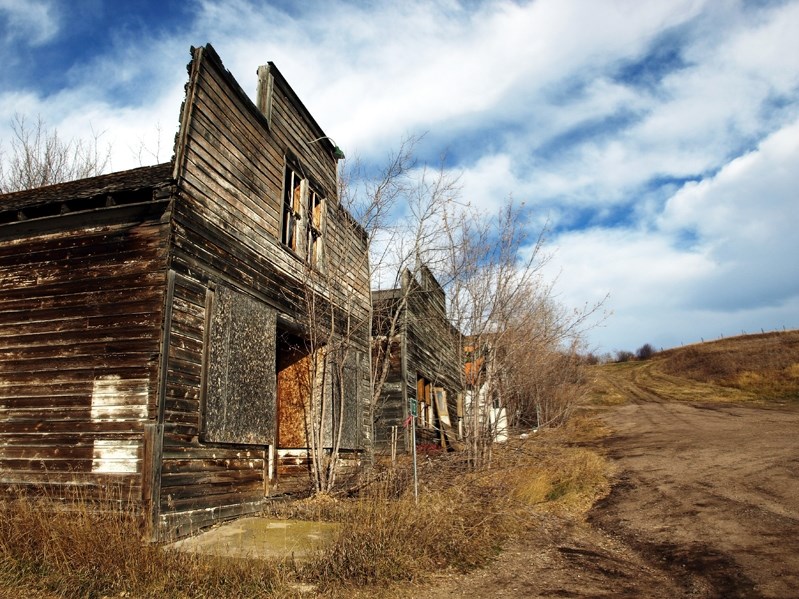It seems somehow fitting this time of year that ghosts will soon be sighted at the Innisfail Public Library. These images are much less haunt than history, however, as the library hosts Ghosts, an exhibit of photographs by local writer and photographer Johnnie Bachusky, showcasing the rapidly disappearing ghost towns of western Canada through a series of stunning images.
The exhibit, which was in Olds earlier this year, will feature a broad range of ghost towns from Western Canada as well as the North West Territories. More precisely, they will depict specific, vital institutions that are representative of what was important to those communities in their heyday. "They are really a celebration of what is left of a particular community," said Bachusky. "It's old church, or hotel, or grain elevator or Main Street."
Bachusky has been travelling around Western Canada documenting ghost towns and cemeteries in photograph for over 20 years, sometimes revisiting the same site several different times for individual projects. "This past year I have spent a lot of time in Lovett, Alberta, for example, working a project. One of the photos in this exhibit is from that body of work," he said.
Bachusky has always been fascinated with history. "Old cemeteries in particular," he said. "I had a girlfriend as a teenager and we used to go on dates to the cemetery. Some people thought that was odd," he laughed.
That interest in history and old cemeteries eventually led to ghost towns. "You often find old cemeteries in ghost towns, so it was a natural progression," said Bachusky.
There are hundreds of ghost towns to be found in Western Canada, giving Bachusky a lot of material to feed his passion. "There are several reasons that there are so many, particularly in this area," he said. "The first is the demise of the grain elevator. When people brought their grain into town, they also utilized the institutes and services of that community. It was the main reason to come into town and they planned their other activities around that event. When the grain elevators died out, so did the reason to come into certain communities, and they, in turn, died out as well."
Other reasons for the demise of many small communities over the years were the consolidation of school services, the evolution of modern transportation and the improvement of highways, along with the discontinuation of some railway lines through certain less-populated areas. "It just became easier to live in larger, more modern centres," said Bachusky.
In some cases, this exodus from the small rural community lifestyle has happened more recently than one may think. In Alberta and Saskatchewan in particular, many towns have become ghost towns just in the past few decades or so, with the growth of the oil and gas industries. "Ghost towns aren't necessarily completely abandoned communities," said Bachusky. "Essentially a ghost town is a community that is a mere shadow of its former self."
Bachusky has taken over half a million photographs of these communities over the years. "These places are rapidly disappearing," he said. "They are being bulldozed or burned to the ground because they have become unsightly or hazardous."
Fortunately, some communities are beginning to develop initiatives to salvage and restore some of the important symbols of the prairie past, such as water towers, grain elevators and old mines.
Bachusky is glad to see those initiatives happening. "These are important symbols of our history," he said. "They deserve to be remembered and to reach the end of their lifespan in a noble manner." In the meantime, he feels compelled to document and honour the fading institutions of the past. "I can't really explain it," he said. "It's a passion that fortunately sometimes morphs into art."
Melinda Mercer, Innisfail library youth/adult programmer, agrees. She and library manager Laurie Hodges Humble both read an article on Bachusky which ran in the Mountain View Gazette, and felt his photography would be a welcome attraction at the library.
"I have a similar fascination with the subject matter, and I can't wait to see the full exhibit," said Mercer. She adds that the Ghosts exhibit is part of a larger plan to incorporate more opportunities for artistic and cultural exposure to the residents of Innisfail, using the library learning centre as a main venue.
Beginning Nov. 15, there will be an introduction to the exhibit displayed at the entrance to the library, and the photographs will be available to view all throughout the library itself. Johnnie Bachusky's Ghosts will be on display until the end of December.
Anyone interested in learning more about Bachusky's work or viewing further examples of his photographs can visit his website, www.nobleghosts.com.



